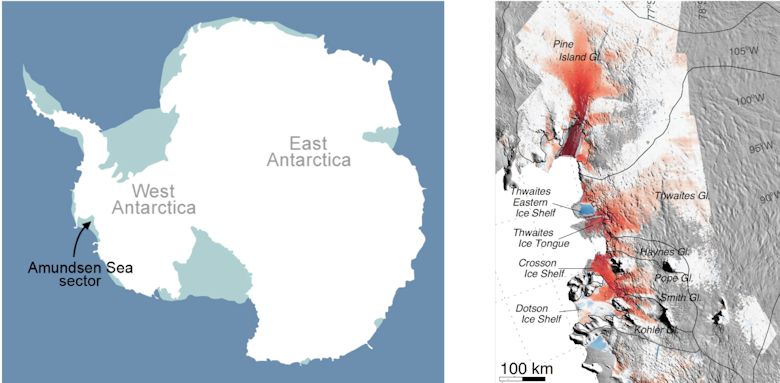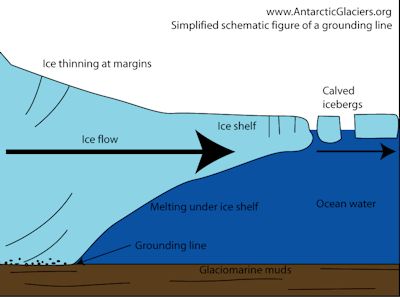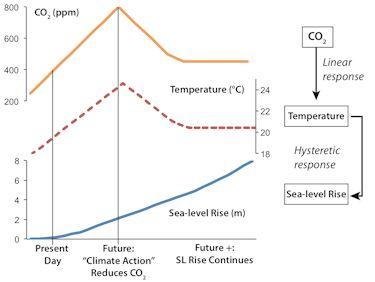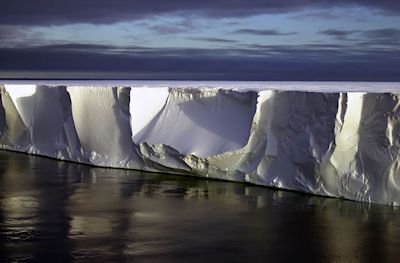
Left: Antarctica actually contains two ice sheets: the East and West Antarctic Ice Sheets. The studies released last month concern the glaciers that flow into the Amundsen Sea, the small embayment below the Antarctic Peninsula in West Antarctica. Illustration: NASA. Right: The six glaciers in the first study are shown on a close-up map of the Amundsen Sea sector. The second study focuses on one of them, the Thwaites Glacier, which drains a large area of West Antarctic Ice Sheet. Illustration: Eric Rignot
Supporter Spotlight
Two scientific studies on melting of the West Antarctic Ice Sheet were published recently, driving a firestorm of sensationalist headlines in the New York Times, National Geographic, CNN and other websites. Dire warnings of unstoppable glacier melt and runaway sea level rise abound. Is this all media hype? If you read no further, the answer is no — this is real.
What’s Going On?
Three major ice sheets remain on Earth today: Greenland, West Antarctica and East Antarctica. Of these, the West Antarctic Ice Sheet, though smallest by volume, is considered the most vulnerable to future melting and collapse. This is because the outer margin of the West Antarctic Ice Sheet sits on bedrock that lies below sea level, unlike the other major ice sheets. Such a “marine-based” ice sheet is sensitive to melting both on the top of the ice, from above-freezing atmospheric temperatures, and below the ice, from incursion of high-salinity ocean water.
Today, the flow of warm (relative to ice), salty ocean water beneath the West Antarctic Ice Sheet is constrained by the contact between the ice sheet and the ground beneath the ice. This is referred to as the “grounding line.” The position of the grounding line relative to the topography beneath the ice sheet is critical to determining the stability of marine-based ice sheets in response to warming.
Specifically, if the grounding line is located on a topographic upslope or ridge, the ice sheet is stable after initial retreat, because thinning and retreat of the ice sheet in response to warming is compensated by a shallower grounding line depth. If the grounding line is located behind a ridge or on a downslope, there is no topographic “catch” for the grounding line, so the ice sheet is unstable and will quickly melt and retreat.
 The studies found that the grounding lines of the glaciers in the Amundsen Sea sector of West Antarctic Ice Sheet have rapidly retreated. Melting from below causes the ice sheet to thin until it is light enough to float. Illustration: Bethan Davies/AntarcticGlaciers.org The studies found that the grounding lines of the glaciers in the Amundsen Sea sector of West Antarctic Ice Sheet have rapidly retreated. Melting from below causes the ice sheet to thin until it is light enough to float. Illustration: Bethan Davies/AntarcticGlaciers.org |
Why does this matter? Glaciers from the Amundsen Sea in West Antarctica contain enough ice to raise sea level by four feet, and have rapidly melted over the past two decades. The two scientific studies published recently provide complementary approaches to addressing the susceptibility of these glaciers to future melting. Eric Rignot, an Earth science professor at the University of California-Irvine and lead author of one study, and his colleagues provide an updated analysis of the topography of the bedrock underneath glaciers in the Amundsen Sea. The authors find that rapid retreat of these glaciers observed over the past 20 years is closely tied with elevation of the bedrock underneath the ice. Importantly, improved imaging of the bedrock underneath the current glaciers shows that, inward of the ridge upon which the grounding lines are presently located, there are no major topographic ridges or other features that may compensate for a thinning ice sheet. If these glaciers continue to melt as they are today, they will eventually enter a highly unstable regime where the entire glacier is susceptible to collapse.
Supporter Spotlight
Ian Joughin, who studies the physics of glaciers at the University of Washington in Seattle, and colleagues use a numerical model to forecast the timing over which such a collapse will occur. Their model correctly reproduces observed rates of melt and glacial retreat over the past 20 years, which gives confidence that the model accurately describes the timing and magnitude of melting in this glacier system. Projecting forward, the authors find that the Amundsen Sea glaciers reach a scenario of complete collapse within 200 to 500 years, and indeed are likely already experiencing an early stage of collapse today.
“Hysteresis”
Many phenomena in the Earth’s climate system are subject to hysteresis –– the dependency of an outcome on not just the current state, but on previous states as well. Hysteresis is perhaps easiest explained visually, as a variable that does not respond in a linear fashion to changes in a causal variable.
 Hypothetical example illustrating the difference between linear responses and hysteretic responses. Note: this represents a major oversimplification of the climate system, and the exact relationships between CO2, temperature and sea-level rise shown here should not be accepted as scientific fact. Hypothetical example illustrating the difference between linear responses and hysteretic responses. Note: this represents a major oversimplification of the climate system, and the exact relationships between CO2, temperature and sea-level rise shown here should not be accepted as scientific fact. |
In the hypothetical example shown at right, the forcing agent (CO2, orange) causes a linear response in temperature (red). When CO2 rises or falls, temperature follows with a corresponding rise or fall. However, the bottom graph of sea-level rise (blue), which is assumed to be forced by temperature, shows a response that is very different from its forcing. The sea-level rise response has inertia from the previous state (increase in temperature), and so is unresponsive to the change in forcing (decrease temperature). In this hypothetical example, sea-level rise exhibits hysteresis. Even if a future corrective action was applied to ameliorate CO2 levels and force a reduction temperature, the sea-level rise persists.
The example is illustrative of perhaps the scariest aspect of Amundsen Sea glacier melting: its hysteresis. Without shallower bedrock to “catch” the grounding line, there is no known mechanism by which collapse of a marine-based ice sheet can be prevented, or reversed. Although glaciology’s knowledge of ice sheet-bedrock interactions is imperfect, the Rignot and Joughlin studies suggest complete melting of the Amundsen Sea glaciers could happen regardless of any future events.
What Happens Once Glaciers Collapse? Take Miami, Florida as an example. Miami-Dade County has a population of 2.5 million, yet averages a mere six feet above sea level today. With a four-foot sea level rise from melting of the Amundsen Sea glaciers, 40 percent of urban Miami-Dade County will be underwater. Moreover, under such a sea-level rise it would take only a two-foot storm surge to inundate 60 percent of modern-day Miami. A recent study estimated that the Miami region receives a two-foot or larger storm surge every ten to twenty years due to hurricane activity, meaning the majority of modern-day Miami would be flooded on a semi-regular basis due to natural storm activity following collapse of the Amundsen Sea glaciers.
Sea-level effects from Amundsen Sea glacier collapse would extend far beyond South Florida. Globally, an estimated 634 million people, almost 10 percent of the global population, live within 30 feet of sea-level. Although more detailed demographic-elevation estimates are not yet available, a significant fraction of this population would likely be endangered from a four-foot sea-level rise, particularly in heavily populated, low-lying areas of Southeast Asia.
Can This Be Stopped?
 The West Antarctic Ice Sheet at 3 a.m. on a December day. Photo: Rutgers Institute of Marine and Coastal Science |
With such risks from sea-level rise, halting the melting of the Amundsen Sea glaciers would appear to be of paramount importance. Any approach to engineer a cessation of melting, however, is quickly overwhelmed by the sheer scale of the problem. Melting of the Amundsen Sea glaciers today is driven by incursion of warmer ocean water; ceasing the melting would thus literally require cooling down the ocean.
Alternatively, the melting of the Amundsen Sea glaciers could be counteracted by an increase in ice gain from additional snowfall on the top of the glacier. However, the volume necessary is staggering: 18.6 billion Goodyear Blimps full of water would have to be frozen onto the Amundsen Sea glaciers each year, just to counteract the ~100 gigatons of ice lost to melt each year observed at present. As the ice sheet continues to destabilize in the future, this volume is expected to rise significantly.
If there is any good news, it is that the rate of collapse of the Amundsen Sea glaciers is estimated to be on the order of several centuries. In his blog, Andy Revkin points out the stark difference between geologic and societal meanings of “collapse;” for geology, a “sudden collapse” still requires multiple human generations. So we have plenty of time to prepare.
In addition, science is never settled. If the incursion of warm oceanic waters in the Amundsen Sea slows down, perhaps the glaciers will recover and avoid collapse. Of course, the opposite — increased warming and an even more rapid collapse — is equally plausible. We may yet learn of new mechanisms that lead to stabilization of marine-based glaciers. But with the state of scientific knowledge at this moment, there is little reason to suspect we can avoid, at a minimum, four feet of sea-level rise in the coming several centuries. Take your talents to South Beach soon.







